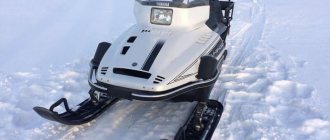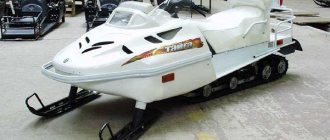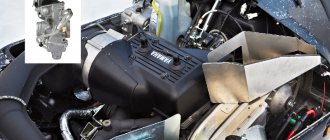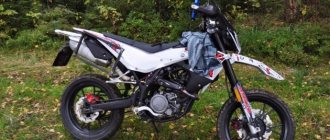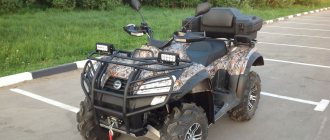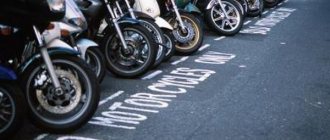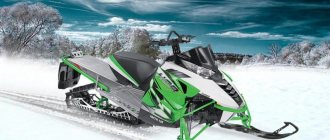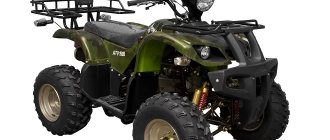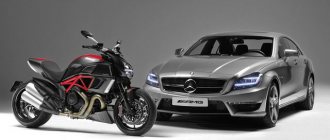Soviet-trained motorcyclists like to say that during the Soviet Union everything was done in good conscience, and engineering was at its best. In particular, they remember with warmth the Voskhod motorcycles, which were not only convenient, but also very prestigious to own. In this article we will look at the technical characteristics of the Voskhod motorcycle.
The history of the Voskhod motorcycle dates back to 1957, when it first rolled off the assembly line of the Kovrov plant. It appeared on the basis of the Kovrovets K-175 model, which underwent significant modifications and changes.
Great success among Soviet consumers prompted developers to create a whole series of these motorcycles. Thus, in less than 10 years, 7 improved modifications of the original version were released.
Among them stands out, the technical characteristics of which were rightfully considered a breakthrough in Soviet motorcycle production. Production of the series ceased more than a decade ago, but even in modern times, Voskhod appears every now and then on domestic roads, no matter how many new prestigious brands appear.
Rear wheel guard
The rear wheel shield with a brake light mounting bracket and a mudguard was used from the Voskhod-3M-01 motorcycle and was attached to the frame at three points. To install it, three holes were drilled, two for M6 bolts and one for an M8 bolt, and the front bracket the mount has been removed.
On both sides of the brake light mounting bracket, two holes with a diameter of 11 mm were drilled for installing direction indicators.
Rear brake
The rear brake drive duplicated on the left side of the motorcycle, which included a lever, an axle and two rods, was removed. A new linkage and rear brake lever were made.
The 580 mm long rod received a plate stop for turning on the brake light. The rear brake lever mounting bracket on the frame remains unchanged.
Rear suspension pendulum
The rear shock absorber mounting brackets on the swingarm were shifted and installed in front of the rear wheel axle. This event made it possible to increase the ground clearance of the motorcycle, which was important since the ground clearance of a motorized motorcycle was significantly less than that of a road motorcycle. The side stand bracket was welded to the left pendulum leg.
Is Kovrovets still alive? Trying to start Voskhod 3M 1965
This example was once also equipped with a 2m, 175cc engine. I was driving 110. Then a two hundred cc engine from an owl was thrown in, this is the same engine as the owl 175, but with a bored cylinder and a different piston head. And yes, unlike the Voskhod two-pipe 175cc model, the owl engine already has a reed valve and as many as three purge windows. And this engine was generally disassembled, machined for a repair piston, and the compression ratio was adjusted to suit the AI-92 benzine. According to the passport, there are 15 mares in it, in reality it is possible a little more, because all the two-hundred cc owls of that time were ridden at once, except for one, which my friend and I did at the same time at an aviation club. The sunrises are coming, brothers.
This is an old engine, still 2m from sunrise. Just in the process of removing the box and elbow, which was later replaced with a new one, although it became bolton. And next to it lies a Soviet crankcase with one broken ear, which was boiled with argon and processed on a lathe to form a mating plane.
This is the same piston from a 175 cc twin, my friend and I sawed it into two halves and made belt buckles, like those of real bikers. By the way, the black on the piston is not carbon deposits, but the same ms-2000 lubricant from the VMP car that I talk about in the video. The 175 cc rode exactly 110 and no more, but this was enough to get around the 175 owls, which are slightly heavier than the Voskhonda. And without lubrication on the piston, of course.
The yarn is still in service.
In short, my point is that so much work was put into this device and knowledge was acquired along the way in the absence of the Internet, that even after 15 years the guy is driving over a hundred with a glow ignition and the wrong mixture. All because there was motivation, and there was only one idiot in our company and he decomposed to death.
The Zid-200 courier was already driving under 130, but it is perfectly tuned, well run-in with MS-2000 grease on the piston and with a 17-teeth front sprocket. And this is very scary - it has larger wheels + the exhaust resonator gives at least 5% of the power due to backpressure from exhaust gases. It’s like on modern stools, only just as miserable as everything from Voskhod. We had one like this and I have never seen anyone else so fast, everyone was driving 110-120 and it was like hitting a wall.
My engine was modernized - it was stripped, the windows were machined, the cylinder itself was machined for the last repair piston and honed to a cone. Well, the weight of the motorcycle is a little lighter than that of its classmates and it rides much more cheerfully, even now.
Here it is important to understand that we measured the speed using the car, but in the video using a phaser, and there the speedometer is also lying on the larger side. But who cares about this at 15 years old, and even now there are already a bunch of Chinese endurics that can be tuned to your heart’s content. And sunrises are forgotten trash. It's a shame to throw it away.
Muffler
In order for the noise level to meet international standards, and the Voskhod-175 SMB-3-01 motorcycle could be used on public roads, the exhaust system of the sports motorcycle was changed.
The muffler mounting tube was moved to the rear of the exhaust pipe and a new muffler was installed. Fixed through a silent block, the new exhaust noise muffler was connected to the exhaust pipe using a rubber coupling and metal clamps.
"Voskhod" conquers sporting peaks
This post will talk about unique small-scale motorcycles produced in Kovrov during the Soviet era. The information was provided to me by the leading designer of the sports motorcycle bureau, who has preserved unique photographs and information about these motorcycles. Then, in terms of parameters, the technology was at the world level. But they didn’t have time to improve reliability; it all came down to technology.
(Total 13 photos)
At the only stage in the world where we managed to show up - in the yuccas near St. Petersburg, the sunrise was 6th, but the gearbox housing tore apart - the casting could not stand it. And so at the USSR championships the sunrises were beyond competition. The designers were not chasing money, but new technical solutions; they worked at night and even on holidays. But in the 90s, everyone realized that motorcycles would not be allowed to go into production and the crisis was forever and we had to somehow survive. Gradually, workers began to quit.
Cross SK-7 Production of 10 pieces per year Water cooling. Weight - 106 kg. Wheel travel is 320 mm. Clutch with dampers. 5 gears. In addition to the traditional method, neutral is activated in any gear using an additional lever under the clutch lever on the steering wheel. Suspensions are fully adjustable for compression and rebound. Power - 52 hp."
Cross motorcycle (SKU-5 and) SKU-6. 1985 Weight - 105 kg. Power - more than 42 hp. Wheel travel is 300 mm. Release 10 pieces per year. (PS There are wings, but they are white, they are overexposed in the photo and cannot be seen)
sunrise 175 shk4 (and shk3) weight 85 kg Power 22 hp max. speed 160 km per hour production of 300 motorcycles per year
In 1991, behind the Iron Curtain, one man created a frameless motorcycle for the Paris Beijing Rally. Since I didn’t have a garage or a house, but only a bed in a factory dorm, I was forced to make it on the factory grounds during overtime. And as soon as I put it on wheels, it was taken away from me with the wording: you made it at the factory and from factory materials. After which I wrote a letter of resignation. When I signed the by-pass sheet, they obliged me to hand over all the albums of drawings and stated that they could handle the rest without me. All I had left were sketches. Photographing and copying without permission from the 1st Department was prohibited. The pendulums are mounted on the engine via subframes with a total weight of 3.5 kg. the steering column passes through the gas tank and the seat on the supporting housing of the air filter. Power of a 500 cc Vtwin is 104 hp. Weight 125 kg. All-wheel drive via automatic overrunning clutch on all wheels. Wheel travel is 300 mm. The rotation angle of the front wheel is 45 degrees in each direction.
This is what Sunrise would have been like in the late 70s. A pilot batch of 250 tok of 300 pieces was produced and equipment for the conveyor was purchased, but the Minister of Defense Ustinov decided for us that the old ones were enough for us. Weight 140 kg power 20 hp max speed 115 consumption 5 liters.
One of the options is 250 current.
Technical specifications
| Engine | 173.7 cm³ |
| Power | 18-20 hp (at 6500-6800 rpm) |
| 4 gears | |
| Weight | 100 kg. |
| Fuel tank volume | 7 liters |
| Wheels | 3,25/19 |
The restored motorcycle “Voskhod-175 SMB-3-01” can be viewed in the private museum of Nikolai Tubaev MOTO-CARPETS.
Soviet motorcycles for ShKMG, part 27: Voskhod - ShK 3.
In 1977, the Kovrovets - 175 ShK was replaced by a new model - Voskhod - ShK 3. Intended for the 175B “Men” and 175 “Women” classes, the motorcycle developed the solutions used on its predecessor.
Photo from the official release.
The front fork is similar to the fork installed on the road Voskhods, but is shortened and has ears on the cups for attaching the wing. The rear shock absorbers are also standard Voskhod shock absorbers. Also, some engine parts are used from standard Voskhod motorcycles. The level of unification with road motorcycles reached 70%. All other parts are original and designed for racing use. Duplex frame made of thin-walled pipes, 18-inch wheels, 160 mm brake drums, original brake mechanisms, clip-ons instead of a steering wheel, short-stroke throttle, friction brake damper, plastic aerodynamic body kit. The exhaust system uses a resonator without a muffler.
Voskhod - ShK 3 on the highway.
Racer G. Johansons.
The Voskhod - ShK 3 engine differs from the engines of other racing Voskhods (SK, SMB) in the gearbox ratios. Each gearbox gear is marked “ShK”. The ignition system is typical for sports equipment from the Kovrov and Minsk plants; it includes a 38A.3437 switch and a 59.3701 generator. At the intake, instead of an air filter, there is a bell that serves as an intake resonator. Carburetors were used both Soviet K-series and Jikov. The motorcycle does not have a kick starter, and a sector with a ratchet was not installed. Engine power: 173.7 cc. reached 17 - 20 hp, this made it possible to accelerate an 80 kg motorcycle to 150 km/h. Cylinder diameter 61.75 mm, piston stroke 58, compression ratio 11 units. Tests during the road circuit racing of the USSR Championship on tracks in Kyiv, Kaunas, Riga and Tallinn were carried out by Master of Sports V. Tyurin (CSKA).
Photo from a festive event in Kovrov in the 70s.
In 1981, the motorcycle was modernized, this was due to the launch of the new Voskhod-3 motorcycle.
An example of a tuned Voskhod ShK3 - non-original body kit parts were used, there were holes in the brake support discs for cooling the brakes. Everything is neat and sound.
Photo of 1987, Sunrise ShK3 No. 13 of the Latvian racer Gunars Johasons.
Among the famous racers who competed at Voskhod - ShK 3, we can mention the Estonian racer Luule Tull. Between 1966 and 1991, she won 21 gold, 7 silver and 3 bronze medals in circuit and hippodrome races. She became the Estonian champion 42 times.
Luule Tull on the highway, 1983.
The estimated annual production is 80 units, but in reality the number of motorcycles produced did not exceed 30 - 40 per year.
Approximate price – 480 rubles.
Voskhod - ShK3 remained in production until 1980. Of course, our riders used them for a long time.
Sunrise at the start.
The few Voskhod ShK-3 that have survived to this day are exhibited in museums, participate in races, and are also present in private collections.
Voskhod - ShK 3 at the races in Riga.
"Time Capsule" - Voskhod - ShK 3, never used in racing. This is exactly how they arrived at the clubs - with unpainted plastic.
Motorcycle by Eldar Khairov from St. Petersburg.
Voskhod - ShK 3, acquired by Nikolai Tubaev from Kovrov.
The same motorcycle after restoration.
Another “new” Voskhod is ShK 3, which stood for many years without use.
Sunrise from Moscow.
Motorcycle from the collection of MOMU Mootorispordi Muuseum, Estonia.
Of course, riders made changes to the design of their motorcycles based on their needs and capabilities. Voskhod - ШК 3 using non-original parts.
Another such Sunrise from Estonia.
Sunrise - ShK 3 1984 by Vadim Chernetsky from Moscow.
The next generation, Voskhod ShK 4, appeared in 1985; this motorcycle became the last in the racing program of the Kovrov plant named after Degtyarev. A story about it in a separate publication.
